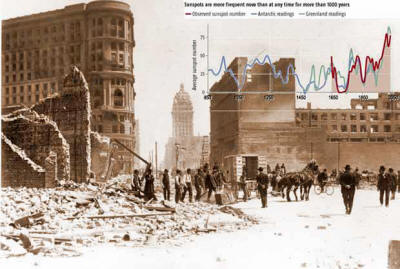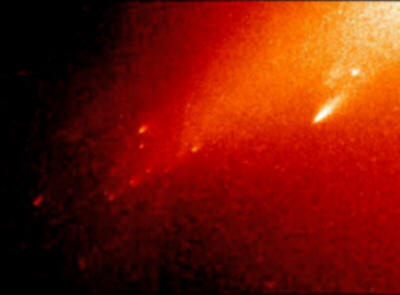|
from HoloScience Website
Chart: New Scientist Some scientists have become aware of a correlation between sunspots and Earthquakes and want to use the sunspot data to help predict earthquakes.
The theory is that an intensification of the magnetic field can cause changes in the geosphere. The NASA and the European Geosciences Union have already put their stamp of approval on the sunspot hypothesis, which suggests that certain changes in the sun-earth environment affects the magnetic field of the earth that can trigger earthquakes in areas prone to it.
It is not clear how such a trigger might
work.
The paper is titled, Rocks That Crackle and Sparkle and Glow - Strange Pre-Earthquake Phenomena, by Dr. Friedemann T. Freund, a professor in the Department of Physics, San Jose State University, and a senior researcher at NASA Ames Research Center.
Dr. Freund writes,
Freund outlines the basic problem,
Freund makes an excellent attempt to explain all of the phenomena in terms of rock acting like a p-type semi-conducting material when placed under stress.
Normally rock is a good insulator. For example, the emission of positive ions from the Earth's surface may act as nuclei for the ground-hugging fog that sometimes occur prior to earthquake activity. And although the surface potential may only be in the 1-2-Volt range, the associated electric field across a thin surface layer can reach hundreds of thousands of volts per centimeter, enough to cause corona discharges, or "earthquake lights."
Thermal anomalies seen from space before an earthquake may
be due to the emission of infra-red light where the semi-conductor
charge recombines at the surface. Disturbed animal behavior may be
due to the presence of positive ions in the air.
Freund laments,
Freund has identified a source of charge in stressed rocks that was not believed possible.
He says,
Confronted with this question, by a twist of logic, many 'mainstreamers' succumb to the impulse to reject the p-hole concept out of hand.
Other geologists find it hard to believe that positive holes liberated so deep down could flow to the Earth's surface and collect there without being reabsorbed. However, earthquake lights are a real phenomenon, and some kind of mechanism must be creating them.
Whatever it is, says Chris Marone, who works on the physics of rock deformation at Pennsylvania State University in University Park, it will involve maintaining charge over surprisingly large distances.
The difficulties encountered in connection with p-holes are similar to others that have punctuated the history of science.
The discovery of the p-holes as dormant yet powerful charge carriers in the Earth's crust calls for a new paradigm in earthquake research and beyond. More often than not, any call for a new paradigm elicits opposition.
Freund closes with a quote from the philosopher Arthur Schopenhauer:
If Freund has a problem getting such a simple idea accepted, how
much more difficult is it going to be to get both astronomers and
geoscientists to accept that the Earth is a charged body in an
Electric Universe?
Changes of voltage on one plate will induce movement of charge on the other. But unlike a capacitor, the Earth also has charge distributed in rock beneath the surface. And if the subsurface rock has become semi-conducting because of stress, there is an opportunity for sudden electrical breakdown to occur through that rock.
We should expect similar processes to occur underground as is found in atmospheric lightning. There will be precursor electromagnetic effects due to the small-scale travelling of charge - rather like "stepped leaders" between cloud and ground.
That may be the limit of activity in small
tremors. But in a large earthquake, the entire circuit may be
involved, from below the Earth, through the atmosphere to the
ionosphere. This would explain the massive disturbance of the
ionosphere over a large area accompanying a major earthquake.
And the link with sunspots via the ionosphere is exposed. Subterranean lightning causes earthquakes! Seismic waves are the rumble of underground thunder. The energy released may be equivalent to the detonation of many atomic bombs but only a small proportion need come from the release of strain in the rocks.
Most
of it comes from the Earth's stored internal electrical energy.
The observation of more than 20 cases of comet fragmentation led to the thought that comet nuclei are poorly cohesive rubble piles. But comet nuclei that have been imaged closely show that they are cohesive, rocky bodies with sharp relief (notwithstanding theoretical speculations about their origin from dust and erroneous densities derived from gravitational theory).
Comet Tempel 1 was no exception yet surprising quantities of extremely fine dust were seen in the Deep Impact experiment. The dust came from electrical sputtering of the rocky comet surface.
An
impact will dislodge much larger particles. The Hubble picture shows that the comet Linear nucleus has been reduced to a shower of glowing "mini-comets" resembling the fiery fragments from an exploding aerial firework. Credit: NASA, Harold Weaver (the Johns Hopkins University),
and the HST Comet LINEAR
Investigation Team. So, being rocky bodies like the Earth and in the same electrical environment of the solar system, comets will carry significant electrical charge distributed throughout the nucleus.
However,
unlike the Earth, conducting plasma is in contact with the comet
nucleus so that electrical discharges reach right down to the
surface where they are concentrated in cathode jets, seen emanating
from the nucleus.
However, the increasing loss of charge from the surface of the comet nucleus, as it rushes toward the Sun, develops electrical strain within the nucleus. If a subsurface discharge results, the comet suffers a "cometquake," which may disrupt the nucleus.
The small velocities imparted to rocks by the quake are sufficient for them to escape the gravity of the nucleus.
|


